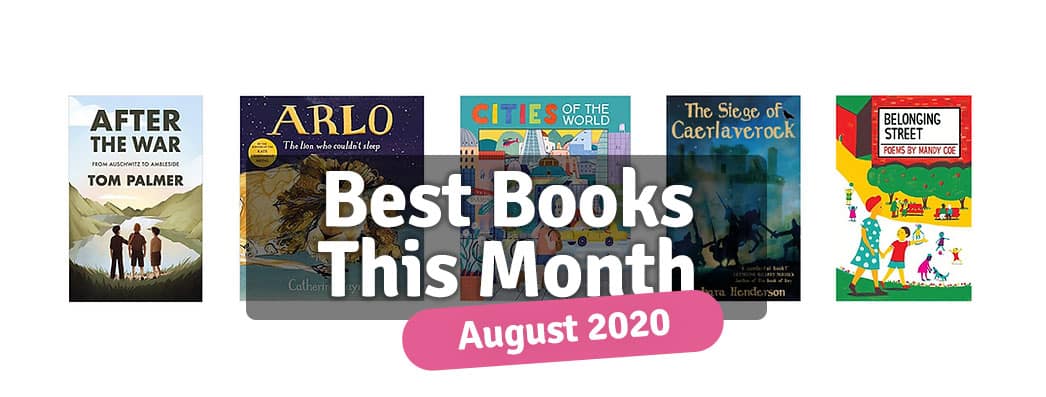August 2020 Top Picks!
We’ve picked five of our favourite new children’s books this month.


We’ve picked five of our favourite new children’s books this month.
If you are already a Tom Palmer fan, you will know to expect from After the War – a touching, concisely told yet never dumbed-down, story of childhood during wartime. If you are new to his books, then prepare to be astounded. Tom Palmer has a rare talent for making the truth of the past accessible to children without watering down the horrific facts or emotional impact, a skill already demonstrated in his previous books, Armistice Runner, D-Day Dog and Over the Line, but in its best evidence yet here.
After the War opens with a foreword explaining the factual basis to this story of the ‘Windermere boys’, 300 refugee children who were temporarily relocated to Cumbria at the end of WWII after being rescued from concentration camps. This is hugely helpful in settling the reader into what to expect of the story ahead and flagging up the timely theme of treatment of refugees.
The story begins in the summer of 1945, as a plane descends into the Yorkshire hills, carrying Jewish child survivors of the Holocaust. Yossi, 15, is traumatized, anxious, untrusting, always alert to danger. Through flashbacks, we gradually learn Yossi’s story, from the day war suddenly arrived in his sleepy Polish village in the form of a German bomber, through being interned in a Jewish ghetto and being forced to work in a clothing factory to his eventual destination, the concentration camps of Auschwitz and Theresienstadt. Balancing between the flashbacks to the horrors of the past and the hope of the future is the present, where the boys gradually settle into Yorkshire life, a place where they learn food is not scarce, uniformed men can have kind eyes, and boys can ride bicycles again.
With Tom’s trademark very short and super-readable chapters, the direct text lets the story shine through straight and true, without ever being overly simplistic in either intent or vocabulary. After the War would make a fantastic class reader for Year 5/6, although I doubt any teacher could make it through without a wobble in their voice at least once a chapter. I spent the majority of the book with a lump in my throat, either at the things that children had been through or at the small touches of kindness shown to them by the local community, which gradually help them to open up to the world again.
The WWII genre is a crowded market, but After the War elbows its way to the front as a stunning reflection on the impact of war, perfectly pitched for a UKS2 audience.
Nominated for “Favourite Books of 2020” by: Richard Simpson (Year 6 Teacher)
Richard says, “Brilliantly written book about an oft-forgotten and not addressed aspect of the war…what happened to those who survived. Powerfully but sensitively dealt with, with moments that will stay with you long after reading it.”
Many of us can relate to the frustration of a sleepness night – especially after this past week of too hot, too stormy or too rainy bedtimes! Arlo the lion is no exception; he is struggling to sleep and feeling helpless at being all out of ideas for what to try next.
Arlo meets Owl, who offers a different perspective. He learns that Owl can sleep through the day – even through the sights and sounds of all the other animals being awake. Fortunately for Arlo, Owl has some sleep-inducing tricks of her own that might just help Arlo too. Owl teaches Arlo a bedtime song, which focuses on thoughts of happy places, a relaxation of the body, a slowing down of breathing patterns and meditation about sinking into the soft ground. The song works a treat, but in his excitement over his new found success, Arlo accidentally wakes other animals up! Happily though, they can use the song too to settle back to sleep.
Parents may like to encourage small children to give Owl’s song a try – or at least one or two elements of the toolbox of strategies it incorporates. The story meets young listeners in the frustrating experience of sleeplessness and moves them gently onwards by empowering little ones with mindfulness techniques tools to try for themselves.
This is a beautifully illustrated tale with a soft, dusk-like palette that blends Arlo’s gentle yellows and browns into the tranquil landscapes of wide, evening skies – almost as if the pictures themselves are willing Arlo to let go and settle into sleep. In fact, the whole story, with it’s gentle pacing and dreamy repetition, is a perfectly pitched winding-down story for busy children.
Barbara’s own book, The Siege of Caerlaverock, is set in Scotland in 1300. Ada’s castle home is under attack. Rocks and flaming arrows rain from the sky as Ada has a dangerous choice to make. Who will survive the siege of Caerlaverock? Find out more about the book on our blog.
The life-affirming ‘You are Here,’ on the first page is a wonderful introduction and sets the positive and optimistic tone for the poems to come with the final line; ‘You are Here! You are Here!’ The book is jam-packed with original verse; all of them perfectly written for reading aloud – well suited for both pure enjoyment and also as a base for children’s own poetry within their English lesson. Each poem explores different aspects of a child’s life; from rainy days in ‘Puddle Ocean’ to wandering around a house at night in ‘Tiptoe’. ‘Helping Hands’ touches on the complexity and diversity within each and every family; it really is beautiful to read and savour, while ‘Save You’ would be a really powerful poem to use as part of topic work around conservation. There’s a tone of warmth and wonder in the collection’s everyday observations that encourages the reader to find so many things to enjoy in the mundane moments that they share with those around them.
Themes of inclusion, positivity and seeing the world through the eyes of others weave through the collection as well as a sense of humour and playfulness that sees puzzles and riddles mixed in with the poems. Belonging Street would be a great investment for every Key Stage Two classroom reading area.


© BooksForTopics 2015-2024
review
Year group(s) the book is most suitable for:
Year group(s) the book is most suitable for:
Does the book contain anything that teachers would wish to know about before recommending in class (strong language, sensitive topics etc.)?
Does the book contain anything that teachers would wish to know about before recommending in class (strong language, sensitive topics etc.)?
Would you recommend the book for use in primary schools?
yes
Curriculum links (if relevant)
Curriculum links (if relevant)
Any other comments
Any other comments